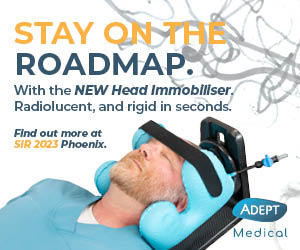|
E-Newsletter • February 2023 |
Editor's E-Note
As the field of interventional radiology has advanced, the scope and number of minimally invasive treatments has grown. These treatments offer many advantages, such as faster recovery times and less risk of infection. This month's newsletter highlights the exciting results of a clinical trial that compared the results of thrombectomy for medium vessel occlusion stroke with the standard of care. Although typically used for blockages of large vessels, the trial found that thrombectomy was safe and technically feasible in medium-sized vessels, as well. Read all of the details in the e-News Exclusive.
What types of minimally invasive procedures does your facility perform? Please let us know on Twitter and/or Facebook. Enjoy the newsletter.
— Dave Yeager, editor |
|
|
| In This E-Newsletter
|
 |
|
|
Thrombectomy Comparable to Medical Management for Strokes
A surgical procedure called thrombectomy is a safe and feasible treatment option for a rare type of stroke, according to a study published in Radiology. Thrombectomy is commonly performed to remove blood clots from brain arteries. It is often done to treat strokes arising from blood clots in the larger arteries that supply blood to the brain. When done promptly, thrombectomy can sometimes be more successful than clot-busting drugs in mitigating long-term damage to the brain.
Recent advances in technology have made it possible to perform thrombectomy in some of the narrower vessels in the head—vessels like the anterior cerebral arteries that arise from the internal carotid artery. However, evidence supporting a potential benefit of thrombectomy for these vessels remains unknown.
As part of the Treatment fOr Primary Medium vessel Occlusion Stroke, or TOPMOST trial, researchers in Germany compared thrombectomy with medical treatment in 154 patients. The patients all had primary isolated anterior cerebral artery medium vessel occlusions, or obstructions. The patients underwent thrombectomy or best medical treatment, which typically involves medications to dissolve the clot and reduce blood pressure. In some cases, patients may receive intravenous thrombolysis, the introduction of clot-busting drugs to the bloodstream or directly to the site of the clot.
▼ ADVERTISEMENT
 |
▼ ADVERTISEMENT

Surgical Planning Made Easier With Ultrafast MRI
An accepted manuscript published in the American Journal of Roentgenology revealed that ultrafast MRI could aid in breast cancer surgery planning by providing valuable information about lesion size and more.
The Future of Medical Writing in the Hands of AI?
An article written entirely by an AI program explains how programs like it could revolutionize medical writing for radiologists and beyond.
‘Texture Analysis’ Distinguishes Between Bone Lesions on MRI
Researchers from several universities united and utilized a novel image processing technique, texture analysis, to distinguish between two types of extremely difficult oral bone lesions on various forms of imaging, including MRI.
▼ ADVERTISEMENT
 |
“If the radiomics analysis is embedded into the routine CT angiography workstation, it can automatically identify vulnerable plaques for clinician review. Thus, radiomics may significantly improve the accuracy and precision of high-risk plaque detection in routine clinical practice. … The results of this study are encouraging and exciting. Radiomics provided a more accurate approach to detect vulnerable plaques compared to conventional coronary CT angiography anatomical parameters.”
— Long Jiang Zhang, MD, PhD, of the department of radiology at Jinling Hospital, Medical School of Nanjing University in China, and colead author of a study published in Radiology regarding a new approach to predicting future cardiac events |
|
|
COVER STORY
Signs of Trouble
Often, imaging can reveal signs of intimate partner violence. Radiologists and physicians must work together to diagnose and address the issue when they see it.
FEATURE
Developing Trust
AI is being used to automate and standardize image interpretation tasks, improving read times and lessening radiologist workload.
|
|
|
| Advertising Opportunities |
Have a product or service you want to market to radiology professionals? Utilize the reach of Radiology Today Magazine to accomplish your marketing goals. Email our experienced account executives today at sales@gvpub.com or call 800-278-4400 for more information.
|
| © 2023 Radiology Today Magazine |
|
|